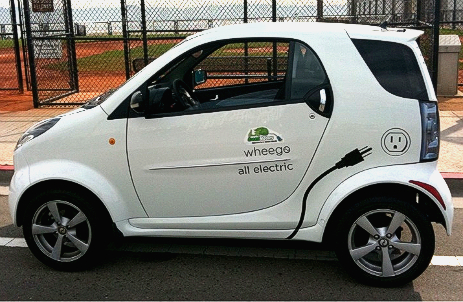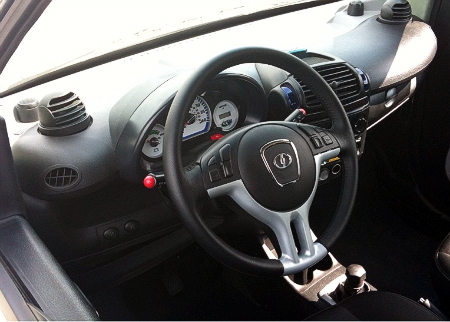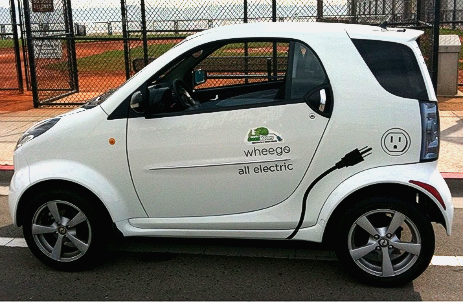 Wheego is an Atlanta-based startup that plans to enter the electric car market with its Whip.Photo: Todd WoodyA traffic jam is developing on the electric highway.
Wheego is an Atlanta-based startup that plans to enter the electric car market with its Whip.Photo: Todd WoodyA traffic jam is developing on the electric highway.
A decade after General Motors killed the electric car, big automakers and startups are revving up to put battery-powered vehicles on the road over the next couple of years. One of the latest entrants is Wheego, an Atlanta company that is about to launch the Whip — a tiny low-speed “neighborhood electric vehicle” that will be upgraded in 2010 to a full-speed, highway-ready car.
Wheego chief executive Mike McQuary brought a Whip to San Francisco last week, and I took the car for a spin around the city. (More on that in a bit.)
You see quite a few neighborhood electrics across the Bay in Berkeley where I live. Their top speed is around 25 miles per hour and many look like glorified golf carts or cast-offs from an East Bloc auto factory, circa 1984. And at the risk of stereotyping, most seem to be driven by the proverbial little old leftist lady in tennis shoes who glides down the hill for the weekly nuclear disarmament rally outside the Cal campus (circa 1984).
The Wheego Whip, on the other hand, looks like a “real” car (PDF brochure). Somewhat similar in appearance to the Smart fortwo or Think City EV, it’s a two-seater microcar sporting all the mod cons — power windows, Bluetooth stereo, iPod/iPhone jack, air conditioning.
Like Coda Automotive’s forthcoming electric sedan, the Whip’s body and chassis are Chinese made — another sign that China is emerging as a player in the nascent electric car industry — while the battery comes from Canada and the motor from Wisconsin (U-S-A! U-S-A!). The Whip will be assembled in California in the Los Angeles exurb of Ontario. Other electric startups are following a similar business plan, making the old Detroit automotive model increasingly look as viable as a Hummer.
McQuary, former president of Internet service provider Mindspring, hopes the little old ladies in tennis shoes will trade their electric buggies for a Whip, but he also has his eye on a different demographic — young and green city dwellers. In other words, you, dear Grist reader.
“Initially, the market’s got to be people who are environmentally conscious,” says McQuary. “I think there is a market for a low-speed vehicle. Clearly, as a city car and I think there’s a lot of beach communities where it’s real practical.”
Then there’s what McQuary calls a “hidden market”: Teenage drivers.
“You got your high school driver, you don’t want him on the highway, you don’t want him doing 55 miles per hour, you don’t want two knuckleheads in the back seat playing peek-a-boo with him,” says McQuary. “You want them to be able to get to school, get to their friends, get to practice and get home. And the insurance rates on a low speed vehicle are much lower than on a full speed car.”
The cost of buying Biff or Amber a Whip, though, is likely to induce whiplash in mom and dad. The low-speed version — it tops out at 25 mph or 35 mph, depending on the state it’s sold in — will set you back about $19,000 before state and federal tax rebates, thanks to its most expensive component, the battery.
The lead-acid battery has a 40-mile range, and the Whip can only legally driven on streets with speed limits of 35 mph or lower. (Which means in a city like San Francisco, connected to the outside world by the Bay and Golden Gate bridges, I wouldn’t be able to drive the Whip home to Berkeley.)
 The interior of the Whip … a little plasticky…Photo: Todd WoodySo, how does a Wheego go? McQuary drove up in a pre-production white Whip near the ballpark on the San Francisco waterfront. The fit-and-finish was a bit rough and plasticky, something I also noticed in the pre-production version of the Chinese-built Coda.
The interior of the Whip … a little plasticky…Photo: Todd WoodySo, how does a Wheego go? McQuary drove up in a pre-production white Whip near the ballpark on the San Francisco waterfront. The fit-and-finish was a bit rough and plasticky, something I also noticed in the pre-production version of the Chinese-built Coda.
Over the past two years, I’ve driven or ridden in several electric cars, from the road rocket that is the Tesla Roadster to the Think City and Coda. Like those cars, the Whip accelerates quickly off the mark as power is transferred instantaneously to the wheels. But I didn’t get that whiplash thrill I did when I punched the accelerator of the similarly sized Think City. McQuary says that’s because the car’s software limits acceleration to avoid spinning the wheels and peeling away from a standing stop (sorry Biff).
As we zipped around downtown San Francisco the Whip held its own, easily maneuvering through traffic and making tight U-turns. It was, of course, a cinch to park. There’s enough space behind the seats to hold several bags of groceries.
The full-speed, 100-mile-range version of the Whip will be powered by a lithium iron phosphate battery and is now undergoing federal crash testing. It will retail for about $29,000 — $21,500 after the federal tax credit — when it goes on sale, now scheduled for June 2010. At that price, it will be competing with Nissan’s Leaf, a polished and futuristic-looking sedan that seats five and is set to hit the market next year.
McQuary says owners of the low-speed Whip will be able to upgrade to the full-throttle version by paying the price difference between the two cars and a small depreciation fee on their trade-in.
He expects to sell 20 times as many full-speed Whips. “We’d like to be a big niche player,” says McQuary. “We don’t have ambitions to overtake one of the majors. But I think if we make a great car and offer really unexpected great service we’ll do fine.”
He offered an analogy from his days at Mindspring and later at Earthlink, where he served as president following a merger between the two ISPs. “Our competitors when we started out were AT&T, AOL, Microsoft and all the Bell companies — huge conglomerates with lots of money. But the thing they could never offer was a personal level of service. And that’s really where I think we’ll make our mark.”
Of course, Earthlink, one of the dominant service providers of the early Internet era, was eventually sidelined by bigger players. It’s still early days for the electric car industry, and it’s anyone’s guess how things will shake out, but the fact that tech veterans like McQuary are jumping into the business suggests that we have a wild ride ahead of us.
—
Video: An interview with Wheego’s Mike McQuary.
Video: Talking With Tami interviews McQuary and goes for a ride.



